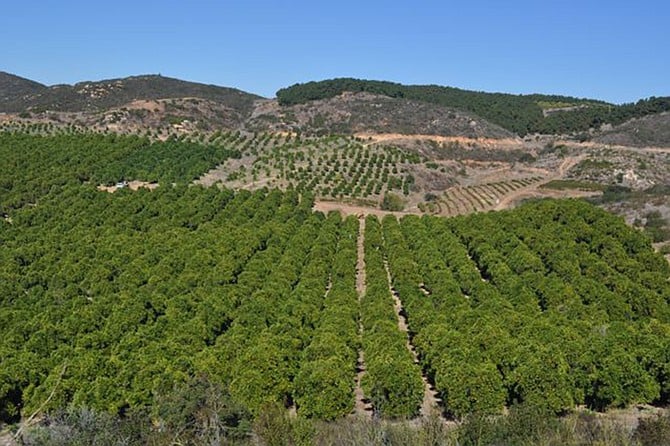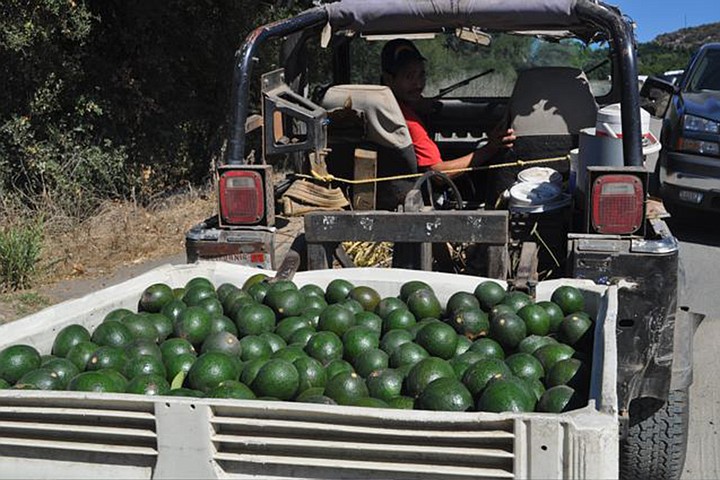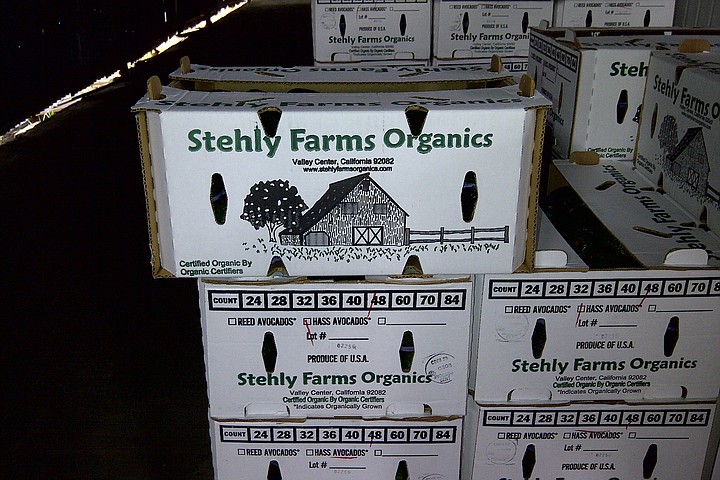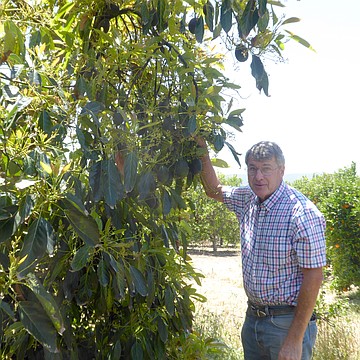 Facebook
Facebook
 X
X
 Instagram
Instagram
 TikTok
TikTok
 Youtube
Youtube

"Find a good well.” That’s what Al Stehly, long-time North County avocado grower recommends, if you want to make a living nurturing what some folks call “green gold.”

Stehly, who owns an 8-acre grove in Valley Center and manages 250 acres for others, has been cultivating those persnickety fruits since the late ’70s. On a blazing September evening, I interviewed him about the highs and lows of cultivating the avocado, this most San Diego-esque of crops. The first thing I noticed is that he pronounces the first “a” in avocado as in “avenue,” not “Ave Maria.” Second, I noticed is what handsome, sturdy stalwarts the trees seem to be. I say seem, because, Stehly explains, they’re picky about where they’re planted and how much they drink.

Valley Center, Fallbrook, and adjacent areas in south Riverside County are the heart of Southern California avocado growing, and anyone who’s driven the stretch of Interstate 15 between Escondido and Temecula has noticed the dense green foliage of the trees and perhaps commented about their propensity to cling to steep hillsides. I’d assumed that it was a drainage issue, but as Stehly explains, “They’re planted on slopes because frost doesn’t gather on the side of hills.” But once a suitable site is located, avocado trees seem a sociable lot. “We’re doing high density, 440 trees per acre.” Higher density has led to higher yields. “We go by acres — it’s 10 to 20 thousand pounds per acre now. And avocado prices keep rising.”

But it’s not all good news, Stehly concedes. “First of all, it takes three years to bear fruit.” (His trees range from one to 25 years old.) And then there’s the matter of water. “It’s pretty tough in San Diego County because of water costs; we spend $6000 - $10,000 per acre per year, probably a tenfold increase from when I first started.”
But what about subsidies? Can’t San Diego’s avocado growers get a leg up from the bureaucrats? When I ask Stehly whether price supports play even a minimal a role in the economics of the County’s avocado production, he responds with a simple “no.” Although prominent in certain sectors of American agriculture (think large-scale field crops such as corn, wheat, soybeans, and other Midwest staples), subsidies aren’t even on the radar screen when it comes to avos. There’s simply no discussion. Yet, Stehly claims, “We’re being pressured by foreign competition all the time.”
If water woes aren’t enough to put a damper on the enthusiasm of nascent guacamole-enablers, Stehly reminds us that green invaders, which hail from from Mexico, Chile, and Peru — less often, New Zealand, Israel, and Egypt — vie for space in supermarket bins. To the surprise of few local shoppers, Mexico is the dominant player among these and is the world’s biggest producer of the Hass, which is the Goliath among commercially-grown avocados. And according to Farmer Al, Hass — frequently misspelled “Haas” — is the only type you’re likely to find at your local Vons or Trader Joe’s.
Are Mexican avocados cheaper? “Prices are similar,” says Stehly, “but Mexico produces so much volume that when they ship, they essentially set the price. They can ship 60 million pounds a week, and although California can do that, it can’t for an extended period of time.” When it comes to battling Mexico for market share, keeping costs down is key, Stehly asserts, “A lot of those [Mexican] groves don’t even need to be irrigated; it’s all just rainfall. Avocado growing is fairly labor-intensive, especially the organic when it comes to weed control. And all the fruit has to be picked by hand.”
Given their year-round availability in San Diego, I wondered: Is there an avocado season? As it turns out, the answer is more complex than one might think.
If your focus is on local specimens, Stehly says that you can expect San Diego County avocados to debut in April. “It starts to really wind down in July,” he says, “although you may still find a few [in September].” Stehly clarifies, “The fruit is ready in late November to mid-December, but we don’t start harvesting until late April or mid-May, after Mexico is done; the Mexican harvest is earlier due to warmer weather. They don’t ripen until you pick them, so we can leave them on the tree for an extended period of time.” But once picked, the ripe is on. “It depends on the time of the year. Early in the season, 10 to 14 days, but later it’s just a couple of days.”
Southern Hemisphere avocados are “just the opposite,” he notes — hitting the stores roughly six months earlier or later, depending on one’s perspective. “In May, June, July, over 90 percent of the avocados you see in the store are local, but the rest of the year, it’s probably 10 - 50 percent. But, he adds, one can find San Diego County 'cados pretty much any time of the year if you include farmers’ markets in the mix. Nonetheless, despite attempts to coordinate North County’s bounty with the influx from points south, Stehly laments, albeit stoically, “We have competition all the time.”
As for cultivation costs, it would seem, given the relatively high cost of land in San Diego County, as well as the finite and diminishing supply of undeveloped but arable acreage, that any discussion of San Diego County agriculture would focus on that factor. But in the case of North County’s hillside orchards, which range from around two to 300 acres apiece, Stehly hasn’t noticed a lot of pressure on growers to sell out; in fact, it’s a buyer’s market. “A lot of growers are looking to get out.” He chuckles, “I don’t think any developers are looking at my property.”
Seems like diversity is a pretty important concept in certain circles nowadays, but if you’re looking for diversity in avocado cultivars, you’re not likely to find it at the nearby superstore. Yes, ma’am — per the California Avocado Commission, there are indeed over 500 varieties of the fruit sometimes referred to (at least in old Southern lingo) as the “alligator pear.” But if you’re speaking of commercially-grown specimens in San Diego County, it has to be Hass, as in Rudolph Hass, who planted three Hass-to-be seeds in La Habra Heights in 1926. While the occasional Bacon or Fuerte may be spotted at a farmer’s market or in a backyard, when I ask Stehly what percentage of the local crop is composed of Hass, he replies, “All of it.”
Revisiting the topic of help from Congress, I ask again, just to make sure I haven’t missed a nuance or two: “Do local growers want subsidies?”
“No, the only thing we want is fair water pricing.”
“What’s ‘fair pricing?’”
“It recognizes that our water is interruptible. In other words, when there’s a drought ‘emergency’ our water supply is shut off, and in the last couple of droughts, there was a 25 to 50 percent cutback. So we should have lower rates than residential and commercial consumers.”
Putting aside for the moment the cyclic nature of precipitation in an intrinsically arid region, and notwithstanding the ongoing debate regarding crop suitability, the viability of avocado growing, according to Stehly, comes down to the availability of water. I asked him if perhaps the local growers have formed a consortium or an informal lobbying group to negotiate lower prices.
“It’s not exactly ‘negotiating,’ but we try to make the case, because our supply is interruptible, our rate should be lower than the homeowners’ rate.”
Do you recommend folks getting into avocado farming?
“It’s tough. The best thing is to seek out a place where the water costs are lower, such as Ventura, or where there’s good well water without much salinity. Not many people go into it unless they have really good well water so they don’t have to buy water, but well water is rare here. No, I wouldn’t quit your day job.”


"Find a good well.” That’s what Al Stehly, long-time North County avocado grower recommends, if you want to make a living nurturing what some folks call “green gold.”

Stehly, who owns an 8-acre grove in Valley Center and manages 250 acres for others, has been cultivating those persnickety fruits since the late ’70s. On a blazing September evening, I interviewed him about the highs and lows of cultivating the avocado, this most San Diego-esque of crops. The first thing I noticed is that he pronounces the first “a” in avocado as in “avenue,” not “Ave Maria.” Second, I noticed is what handsome, sturdy stalwarts the trees seem to be. I say seem, because, Stehly explains, they’re picky about where they’re planted and how much they drink.

Valley Center, Fallbrook, and adjacent areas in south Riverside County are the heart of Southern California avocado growing, and anyone who’s driven the stretch of Interstate 15 between Escondido and Temecula has noticed the dense green foliage of the trees and perhaps commented about their propensity to cling to steep hillsides. I’d assumed that it was a drainage issue, but as Stehly explains, “They’re planted on slopes because frost doesn’t gather on the side of hills.” But once a suitable site is located, avocado trees seem a sociable lot. “We’re doing high density, 440 trees per acre.” Higher density has led to higher yields. “We go by acres — it’s 10 to 20 thousand pounds per acre now. And avocado prices keep rising.”

But it’s not all good news, Stehly concedes. “First of all, it takes three years to bear fruit.” (His trees range from one to 25 years old.) And then there’s the matter of water. “It’s pretty tough in San Diego County because of water costs; we spend $6000 - $10,000 per acre per year, probably a tenfold increase from when I first started.”
But what about subsidies? Can’t San Diego’s avocado growers get a leg up from the bureaucrats? When I ask Stehly whether price supports play even a minimal a role in the economics of the County’s avocado production, he responds with a simple “no.” Although prominent in certain sectors of American agriculture (think large-scale field crops such as corn, wheat, soybeans, and other Midwest staples), subsidies aren’t even on the radar screen when it comes to avos. There’s simply no discussion. Yet, Stehly claims, “We’re being pressured by foreign competition all the time.”
If water woes aren’t enough to put a damper on the enthusiasm of nascent guacamole-enablers, Stehly reminds us that green invaders, which hail from from Mexico, Chile, and Peru — less often, New Zealand, Israel, and Egypt — vie for space in supermarket bins. To the surprise of few local shoppers, Mexico is the dominant player among these and is the world’s biggest producer of the Hass, which is the Goliath among commercially-grown avocados. And according to Farmer Al, Hass — frequently misspelled “Haas” — is the only type you’re likely to find at your local Vons or Trader Joe’s.
Are Mexican avocados cheaper? “Prices are similar,” says Stehly, “but Mexico produces so much volume that when they ship, they essentially set the price. They can ship 60 million pounds a week, and although California can do that, it can’t for an extended period of time.” When it comes to battling Mexico for market share, keeping costs down is key, Stehly asserts, “A lot of those [Mexican] groves don’t even need to be irrigated; it’s all just rainfall. Avocado growing is fairly labor-intensive, especially the organic when it comes to weed control. And all the fruit has to be picked by hand.”
Given their year-round availability in San Diego, I wondered: Is there an avocado season? As it turns out, the answer is more complex than one might think.
If your focus is on local specimens, Stehly says that you can expect San Diego County avocados to debut in April. “It starts to really wind down in July,” he says, “although you may still find a few [in September].” Stehly clarifies, “The fruit is ready in late November to mid-December, but we don’t start harvesting until late April or mid-May, after Mexico is done; the Mexican harvest is earlier due to warmer weather. They don’t ripen until you pick them, so we can leave them on the tree for an extended period of time.” But once picked, the ripe is on. “It depends on the time of the year. Early in the season, 10 to 14 days, but later it’s just a couple of days.”
Southern Hemisphere avocados are “just the opposite,” he notes — hitting the stores roughly six months earlier or later, depending on one’s perspective. “In May, June, July, over 90 percent of the avocados you see in the store are local, but the rest of the year, it’s probably 10 - 50 percent. But, he adds, one can find San Diego County 'cados pretty much any time of the year if you include farmers’ markets in the mix. Nonetheless, despite attempts to coordinate North County’s bounty with the influx from points south, Stehly laments, albeit stoically, “We have competition all the time.”
As for cultivation costs, it would seem, given the relatively high cost of land in San Diego County, as well as the finite and diminishing supply of undeveloped but arable acreage, that any discussion of San Diego County agriculture would focus on that factor. But in the case of North County’s hillside orchards, which range from around two to 300 acres apiece, Stehly hasn’t noticed a lot of pressure on growers to sell out; in fact, it’s a buyer’s market. “A lot of growers are looking to get out.” He chuckles, “I don’t think any developers are looking at my property.”
Seems like diversity is a pretty important concept in certain circles nowadays, but if you’re looking for diversity in avocado cultivars, you’re not likely to find it at the nearby superstore. Yes, ma’am — per the California Avocado Commission, there are indeed over 500 varieties of the fruit sometimes referred to (at least in old Southern lingo) as the “alligator pear.” But if you’re speaking of commercially-grown specimens in San Diego County, it has to be Hass, as in Rudolph Hass, who planted three Hass-to-be seeds in La Habra Heights in 1926. While the occasional Bacon or Fuerte may be spotted at a farmer’s market or in a backyard, when I ask Stehly what percentage of the local crop is composed of Hass, he replies, “All of it.”
Revisiting the topic of help from Congress, I ask again, just to make sure I haven’t missed a nuance or two: “Do local growers want subsidies?”
“No, the only thing we want is fair water pricing.”
“What’s ‘fair pricing?’”
“It recognizes that our water is interruptible. In other words, when there’s a drought ‘emergency’ our water supply is shut off, and in the last couple of droughts, there was a 25 to 50 percent cutback. So we should have lower rates than residential and commercial consumers.”
Putting aside for the moment the cyclic nature of precipitation in an intrinsically arid region, and notwithstanding the ongoing debate regarding crop suitability, the viability of avocado growing, according to Stehly, comes down to the availability of water. I asked him if perhaps the local growers have formed a consortium or an informal lobbying group to negotiate lower prices.
“It’s not exactly ‘negotiating,’ but we try to make the case, because our supply is interruptible, our rate should be lower than the homeowners’ rate.”
Do you recommend folks getting into avocado farming?
“It’s tough. The best thing is to seek out a place where the water costs are lower, such as Ventura, or where there’s good well water without much salinity. Not many people go into it unless they have really good well water so they don’t have to buy water, but well water is rare here. No, I wouldn’t quit your day job.”
Comments